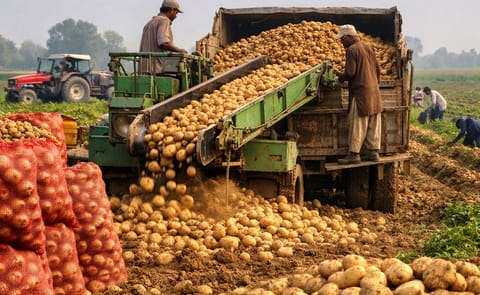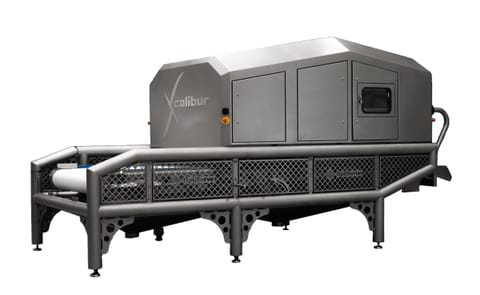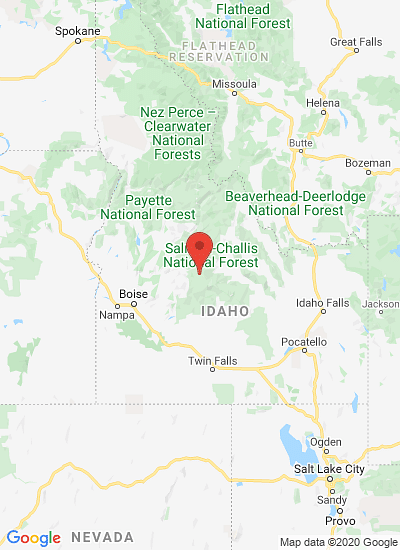Potato fields in Idaho. Idaho is the US state producing the most potatoes, followed by Washington.
The top six potato varieties grown in the United States (Fall Crop)

In this article, PotatoPro wants to give you an in depth insight in the potato varieties grown in the United States. We generated a Top 6 potato varieties based on the USDA data for the 2016 fall potato crop.
In its statistics, the USDA distinguishes a spring, summer and fall potato crop, but the fall potato crop is by far the largest segment, typically accounting for over 90% of the weight of the potatoes harvested. The top six presented below is based on the by the USDA reported acreage (not harvested weight) in 2016 in seven top potato growing states as a percentage of the total fall acreage in those states: Idaho, Maine, Minnesota, North Dakota, Oregon, Washington and Wisconsin.
We have included all the varieties cultivated on over 2.5% of the potato acreage in these seven states. You can find more information on the varieties in each of these states by visiting the PotatoPro pages of these states. We have listed all varieties that are over a 3% threshold in that specific state.
Top 6
#1 Russet Burbank
#2 Russet Norkotah
#3 Ranger Russet
#4 Umatilla Russet
#5 Frito-Lay varieties
#6 Norland
Click the link or just scroll down to learn more on each of these varieties.
Russet Burbank
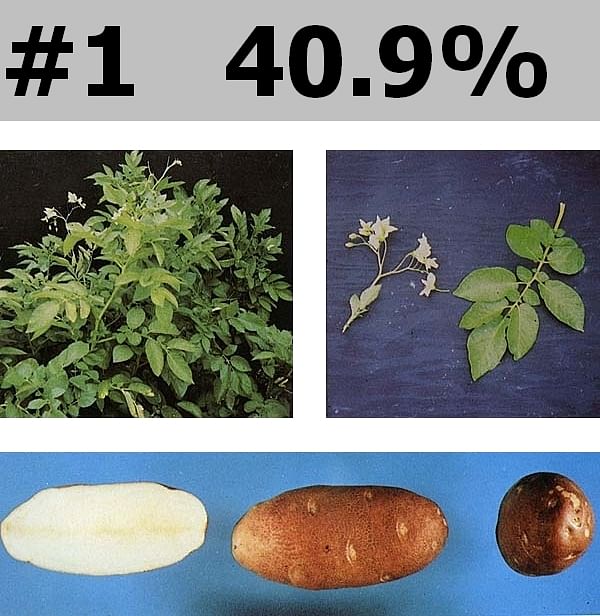
Russet Burbank
Synonyms
Idaho Russet, Netted Gem
Origin
The origin of Russet Burbank was reported by Luther Burbank in 1914 as being a chimera selected from the variety Burbank by Lou Sweet. Lou Sweet was a potato grower in the western slope area of Colorado and was President of the Potato Association of America in 1920.
Characteristics
A late maturing variety that requires a 140 to 150 day growing season to produce maximum yields and quality. Yields are moderately high ranging from 250 to 600 cwt/A (28 to 67 t/ha). The cultivar is well adapted and primarily grown with irrigation in the northwestern states of Idaho, Washington, Oregon, Montana, and in Canada. It is also grown in several north-central and mid-western states.
Plants are vigorous, spreading and have an indeterminate type of growth. Stems are thick, prominently angled and finely mottled. Leaflets are long, medium in width and light to medium green in color. The blossoms are few, white and not fertile. Tubers are large, long and cylindrical or slightly flattened with russeted skin. They eyes are shallow and the flesh is white.
Strengths & Weaknesses
The variety is the standard for excellent baking and processing quality. The cultivar is tolerant to common scab but is susceptible to Fusarium and Verticillium wilts, leafroll and net necrosis and virus Y. Jelly-end and sugar-end develop in tubers when plants are subjected to stress. Plants require conditions of high and uniform soil moisture and controlled nitrogen fertility to produce tubers free from knobs, pointed ends and dumbbells. It is a good long-term storage potato for tablestock and processing.
Source: PAA
Russet Norkotah
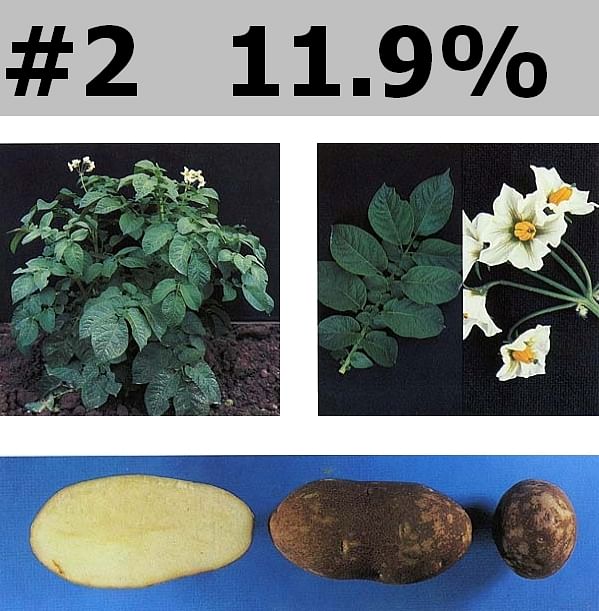
Russet Norkotah
Origin
Selected from a cross made in North Dakota between ND9526-4 Russ x ND9687-5 Russ and tested as ND534-4 Russ. Released by North Dakota in 1987.
Characteristics
Russet Norkotah is an early to medium maturity cultivar grown primarily for the fresh market. Yields are medium and tuber specific gravity is low to medium. Plants are medium sized, slightly upright; stems are medium thick with non-pigmented nodes and internodes. Leaves are medium in size, open and slightly pubescent. Buds are slightly pigmented, corolla is white and anthers are yellow-orange. Tubers are long to oblong, smooth, russeted and have shallow, bright golden eyes. Tuber flesh is white, dormancy is medium and sprouts are white with some purple pigment at the tip.
Strengths & Weaknesses
Russet Norkotah has a very attractive general appearance with a high percentage of U.S. No. 1 tubers. Tuber shape and type are very desirable for the count-carton market. The variety is not well suited for processing. It is adaptable to many of the growing areas.
Russet Norkotah is susceptible to most viruses and late blight. It is very susceptible to Verticillium wilt and early blight. It is reported to have some tolerance to common scab and silver scurf.
Source: PAA
Ranger Russet

Ranger Russet
Origin
Ranger Russet was first selected at USDA-Aberdeen, Idaho in 1977 from a cross of Butte x A6595-3. It was tested as A7411-2 and was released by the USDA, Idaho, Oregon, Washington and Colorado in 1991.
Characteristics
Ranger Russet is a full season variety which produces high yields of high quality, long, russet-skinned tubers which are slightly flattened. It is well suited for frozen processing and fresh market.
Plants are large and upright to spreading. Stems are thick, green which can be light brownish to light purple in full sun. Leaves are large, broad and medium green. Flowers are abundant. Buds are green with reddish-purple base and pedicel and moderate amount of short pubescence. Corolla is medium large, red-purple color and anthers are bright yellow.
Tuber skin is tannish brown and not scaly. Eyes are plentiful, moderately shallow to deep and well distributed. Dormancy is medium.
Strengths & Weaknesses
Ranger Russet is more resistant than Russet Burbank to Verticillium wilt, PVX, PVY, leafroll net necrosis and Fusarium dry rot. It is highly resistant to hollow heart. It produces higher U.S. No. 1 yields and specific gravity than Russet Burbank. It is susceptible to common scab and is more susceptible to blackspot bruise than Russet Burbank.
Source: PAA
Umatilla Russet

Umatilla-Russet
Origin
Umatilla Russet was bred by Dr. J. J. Pavek in Aberdeen (Idaho) from the cross (Butte x A77268-4) and released jointly by the Oregon, Idaho and Washington Agricultural Experiment Stations and the USDA in 1998.
Characteristics
The Umatilla Russet is a medium late potato variety, wiht medium to high yield and good tuber uniformity. Tuber specific gravity is higher and more uniform than Russet Burbank; lighter fry color that holds up well throughout the storage season. Less susceptible than Russet Burbank to tuber shape and physiological problems induced by moisture stress. Relatively resistant to hollow heart, brown centre and internal brown spot. Medium long dormancy period.
Umatilla Russet is a very good variety for boiling, baking, frying and chipping; excellent choice for processing because of low sugar and high starch content.
Source: CFIA
Frito-Lay varieties
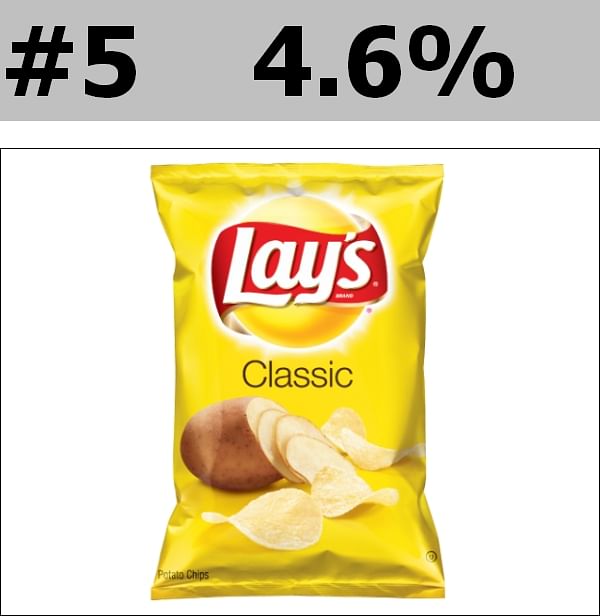
Frito-Lay varieties
This statistic refers to a basket of one or more proprietary potato varieties used by Frito-Lay (Pepsico) for the production of potato chips in the United States.
Norland
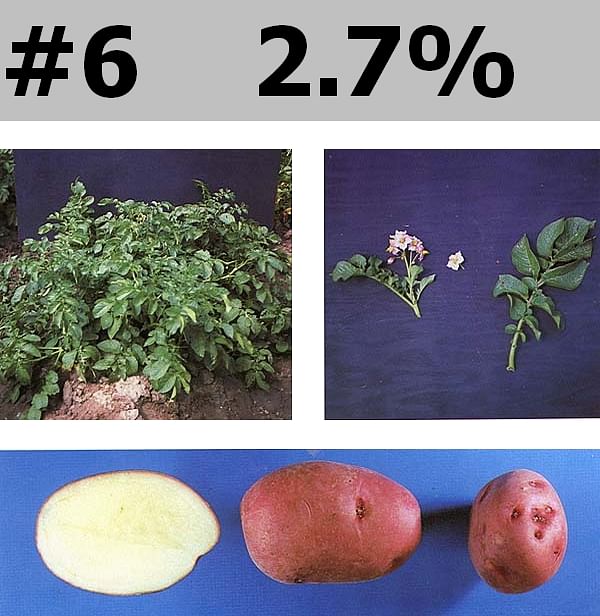
Norland
Origin
Norland was tested as ND2908-1R and released by the North Dakota Agricultural College in 1957. The parentage is Redkote xND626. Several darker red-skinned strains of Norland have been selected since its release.
Characteristics
Norland is widely adapted, early maturing and has a determinate type of growth. Plants are medium large and spreading with stems that are medium-thick and prominently angled. Nodes are slightly swollen and green with green internodes and waved wings. Leaves are medium to large, slightly closed and medium green. Leaflets are ovate, acute lobed and asymmetrical. Petioles are green. Flowers are purple with medium-large orange anthers with abundant pollen.
Tubers are oblong, smooth, slightly flattened, medium red with shallow eyes. Specific gravity is low to intermediate and yields are low to intermediate.
Strengths & Weaknesses
Tubers are excellent for boiling and frying and fair for baking. The variety seldom produces off-type, knobby or growth-cracked tubers and it is not susceptible to internal defects. It is tolerant to common scab but is susceptible to infection by the common viruses, early blight, late blight and air pollution injury. Red skin color decreases after tubers mature.
Source: PAA

